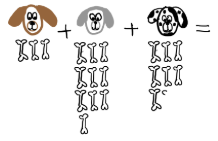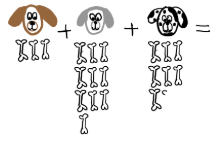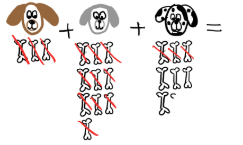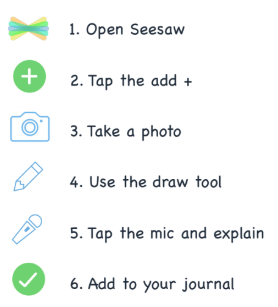
Adding Three Numbers With SeeSaw

Overview
Seesaw is a web-based and application platform where students can post pictures from the classroom, annotate, speak their mind, and create electronic portfolios that connect school and home.Parents are able to see student work as soon as it is posted.
In this activity, students will solve a math problem with three integers and explain their thinking using SeeSaw.
Learning Objectives
Students will:
- Be able to explain their thought process of solving a three number story problem and post their explanation to SeeSaw.
Vocabulary
Vocabulary Words:
- Story problem: A story problem is also known as word problems, which require you to read a problem and decide which operation to perform in order to get the answer.
Pre-planning
To prepare for this lesson:
Before the lesson, teachers must set up SeeSaw accounts for their classes and invite parents to join.
-
Please view the TEACHER video on using SeeSaw in the classroom.
-
Students should also know the basic features of SeeSaw.
-
Please view the following videos to decide how your students will access SeeSaw. Students can access it with email, a class code, or a QR code.
-
-
Here is a student video on how to use SeeSaw.
-
The SeeSaw app needs to be downloaded on student devices or bookmarked on computers.
-
Teachers will need to have math manipulatives available for counting.
Note: SeeSaw has many other tutorials on their website and Help Center.
Accommodations
See the Accommodations Page and Charts on the 21things4students website in the Teacher Resources.
Steps
Directions for this activity:
-
Students have been adding three numbers together in story problems before this lesson. Today, they will read a story problem with three numbers and explain their thinking while recording on SeeSaw.
-
Explain to students that sometimes, we need to add more than two numbers together when working with a story problem. The teacher then shows an example problem with pictures and/or math manipulatives.
Example: The brown dog has 3 bones, the gray dog has 10 bones, and the spotted dog has 7 bones. How many bones do all the dogs have together?

-
As you count the bones, model how to explain your thinking. You might say, “I need to tell you what I’m thinking. I’m going to count each of the bones the dogs have to know how many bones there are all together. As I count, I’m going to cross out each bone so I know I already counted it. Let’s count together…. 1, 2, 3….”

-
Once you have finished counting all the bones, model answering the question in a full sentence. You might say, “the dogs have 20 bones all together.”
-
Independent Work: Students take what they have learned about 3 number addition and draw their problem or use manipulatives to explain their thinking. Tip: Students might want to draw or take a picture first before recording. Then, talk about their problem while using the annotate and record function of SeeSaw.
-
Students open the SeeSaw app and press the “+” sign, then select the camera icon to take a photo.
-
Next, students select the draw tool to label their picture.
-
After labeling their picture, students tap the microphone and explain their thinking.
-
When finished, students select the green check to add it to their journal.
Note: Here is a photo of the steps to add and explain a photo in SeeSaw:


Assessment Options
Different options for assessing the students:
- Observations
- Check for understanding
- Teachers can see what students have posted to their journal from the Teacher side of SeeSaw. They are able to leave feedback for students and intervene with any students who does not get the pattern concept.
MITECS Competencies & ISTE STANDARDS
MITECS: Michigan adopted the "ISTE Standards for Students" called MITECS (Michigan Integrated Technology Competencies for Students) in 2018.
Computational Thinker
5c. Students break problems into component parts, extract key information, and develop descriptive models to understand complex systems or facilitate problem-solving.
Devices and Resources
SeeSaw works on all devices, but works best on devices with a camera and microphone.
Websites:
Get Students Started on Seesaw: Sign in with a code
CONTENT AREA RESOURCES
Math
CCSS.MATH.CONTENT.1.OA.A.2
Solve word problems that call for addition of three whole numbers whose sum is less than or equal to 20, e.g., by using objects, drawings, and equations with a symbol for the unknown number to represent the problem.
CREDITS
This task card was created by Lacey Khon, KRESA, November 2018. Updated November 2023.


